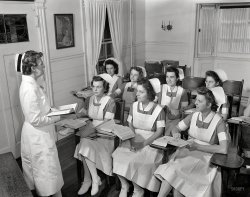
MAY CONTAIN NUTS

Search Shorpy
SHORPY ART

Framed or unframed, desk size to sofa size, printed by us in Arizona and Alabama since 2007. Explore now.
Join and Share
Ad-Free Shorpy
Shorpy is funded by you. Patreon contributors get an ad-free experience.
Learn more.

Recent comments
- Details, Details
- What's that building to the left of the tower?
- Coal Barges
- Bromo-Seltzer
- Inner harbor
- The Basin
- What a headache!
- Giant stepladder?
- Baldwin 62303
- Baldwin VO-1000
- Cold
- No expense spared
- Tough Guys
- Lost in Toyland
- And without gloves
- If I were a blindfolded time traveler
- Smoke Consumer Also Cooks
- Oh that stove!
- Possibly still there?
- What?!?
- $100 Reward
- Freeze Frame
- Texas Flyer wanted
- Just a Year Too Soon
- WWII -- Replacing men with women at the railroad crossing.
- Yes, Icing
- You kids drive me nuts!
- NOT An Easy Job
- I wonder
- Just add window boxes
Member Photos
The Shorpy
Print Emporium
Print Emporium
Search Shorpy
Search results -- 30 results per page
- Listening Post: 1942
- Rochester, New York. "Mr. Babcock tuning in for war news." Howard B. in the ... the parent club of the local minor league (AAA) team the Rochester Red Wings. Today the Red Wings are affiliated with the Minnesota ... and coal. -tterrace]
(The Gallery, Ralph Amdursky, Rochester, WW2) ... Posted by Dave - 06/16/2013 - 11:43am -
![Listening Post: 1942 Rochester, New York. "Mr. Babcock tuning in for war news." Howard B. in the latest installment of the Babcock saga; the photos, with a publication date of March 1943, seem to be from September 1942 if the newspaper is indeed new. Photo by Ralph Amdursky for the Office of War Information. View full size.
Furniture placementDoesn't he know that having the chair so close to the radio will damage his ears?
How I RememberI remember how fascinated I was by those little string covered pulls on the blinds when I was a small kid. I think I pulled a few off in my day. Does anyone know what they are called? They are way too fancy NOT to have a name. The man's socks and shoes are over the top! He would have been considered quite stylish at the time.
[Those are windowshade pulls. - Dave]
Those shoes!They're either very ugly, or very stylish. But they're definitely very something.
There's a two-out-of-three chance that Mr. Babcock was committing a white-after-Labor Day faux pas. He'd be okay if the date is Sunday, September 6, but not if it's the 13th or the 20th. The date cannot be Sunday, September 27 as that was the last day of the regular baseball season when the Cardinals won the NL title by defeating the Cubs, and the newspaper refers to the Cards and the Dodgers as being even.
Western AutoTruetone was the store brand of Western Auto stores. The radios they sold were not actually made by Western Auto, rather they were made for them by other radio manufacturers--usually ones with names lesser known than Truetone, such as Belmont or Wells Gardner. This man bought his enormous radio just in time: it is a 1942 model, the D1144, and wouldn't have been available for long after civilian radio production ceased for the duration of WW2.
As usual, the devil reposes in the detailsNow, the first nit one might pick is that the Democrat & Chronicle was the morning Gannett paper, and the Times-Union the afternoon, and it looks to be late afternoon when the photo was taken, but the paper indicates that it is Sunday, so the T-U would not have been published that day. Evidently, the possible staleness of the news is what prompts Mr. Babcock to seek out H.V. Kaltenborn or Gabriel Heater via the ether. I cannot make out the date, but as it's September, we may have Mr. Babcock on a "white after Labor Day" offense with respect to those snazzy shoes.
September 13I can't make out the date, but the headline about the Cardinals and Dodgers being tied in the standings means this must have been Sunday, September 13.
The Cardinals and Dodgers finished a two-game series on Saturday and were tied for first in the National League for the only time that season (the Cardinals went on to win the National League and the 1942 World Series). The Saturday game featured 6 future Hall of Famers (Enos Slaughter, Stan Musial, Billy Herman, Joe Medwick, Pee Wee Reese, and Arky Vaughan). It was a critical turning point because up until that series the Dodgers had led the National League since the first week of the season.
Assuming this was taken that Sunday, the Dodgers would have likely just finished getting swept in a double header against the Reds, capping a five-game losing streak (significant since they finished the season 2.0 games behind the Cardinals).
Cool shoes!Literally speaking. They must have been very comfortable on hot days with all those holes in the uppers. I think they were house shoes because people didn't get rid of their street shoes and wear out their expensive socks around the house. Dress socks like those are still around the same price as a dinner out.
Shade PullTahoemike, I was fascinated with looking out the window too! The Christmas wreaths we had for those windows were no bigger around than one of today's dinner plates.
The chair! The blind pulls!We had a chair exactly like that when I was young! And I haven't seen pulls like those in ages!
Ah! The Doily Headrest!My mom put those on every chair and sofa in the house. I remember asking her once what purpose they served.
"To protect the furniture from oily hair", she replied.
"But we shower ever every day", I replied.
"No matter", she replied (somewhat indignantly) - and that was THE END of that conversation.
[Your mom was right. That's why that "doily" is actually called an antimacassar. -tterrace]
Upsidedown umbrellasTwo on top of the radio. What did they hold?
Flowers? Toothpicks? Cigarettes?
There's always eBay...for old-fashioned shade pulls.
Timely stockingsI think those arrows on his socks are called clocks. They were very popular on women's stockings in the 20's and earlier.
[And men's, too. -tterrace]
Why the CardinalsThe reason the D&C is featuring the St. Louis Cardinals is they were the parent club of the local minor league (AAA) team the Rochester Red Wings. Today the Red Wings are affiliated with the Minnesota Twins and the D&C is still being published (although it's a ghost of its former self).
Re: Timely StockingsAre those stockings also known as "spats"?
[No; spats fit over the shoe. -tterrace]
Comfortable homefrontPlush setting belies the fact there is a war. I wonder if electrical power was rationed?
[The furnishings here are typical for a middle-class family home of the time. Wartime restrictions on certain commodities did not extend to confiscation of people's existing possessions. Electricity as such was not rationed, though conservation was encouraged to help conserve electrical-generating materials such as oil and coal. -tterrace]
(The Gallery, Ralph Amdursky, Rochester, WW2)](https://www.shorpy.com/files/images/SHORPY_8d27674a.thumbnail.jpg)
- Roll Your Own: 1904
- Despatch (East Rochester), New York, circa 1904. "Shops and transfer yards, Merchants Despatch ... youse call brake shoes!
(The Gallery, DPC, Railroads, Rochester) ... Posted by Dave - 08/06/2012 - 6:27pm -
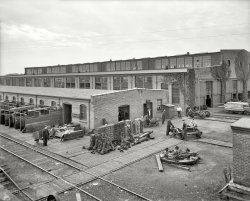
- Dr. Bliss: 1920
- ... Bliss, Former Chiropractor Here,
Tries to Die in Cell at Rochester, N.Y.
HELD ON BIGAMY CHARGE
Taken to Hospital, Where Doctors ... to the Washington Post.
Rochester, N.Y., Nov. 1 -- An hour after being locked up at police headquarters ... Posted by Dave - 09/13/2011 - 11:30pm -
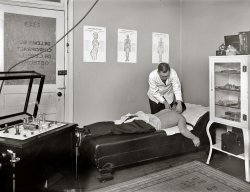
- The Storeroom: 1904
- East Rochester, New York, circa 1904. "Storeroom at Merchants Despatch ... and granite everywhere!
(The Gallery, DPC, Railroads, Rochester) ... Posted by Dave - 08/14/2012 - 11:37am -
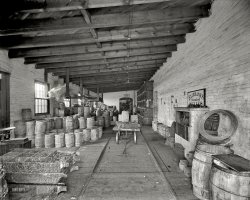
- The Blacksmiths: 1904
- ... of the refrigerated rail freight line in what is now East Rochester. Panorama of two 8x10 glass negatives. View full size.
... I'm trying to replicate.)
(Panoramas, DPC, Factories, Rochester) ... Posted by Dave - 07/19/2012 - 10:21pm -
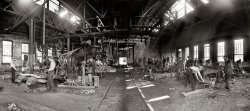
- Texanna Loomis: 1921
- ... State of her birth –- she later moved with her family to Rochester, N.Y., and there she received her early education. Not until the ... Posted by Dave - 09/11/2011 - 8:06pm -
![Texanna Loomis: 1921 December 31, 1921. "Miss Texanna Loomis." Mary Texanna Loomis, founder and proprietor of the Loomis Radio School in Washington, D.C. National Photo Company Collection glass negative, Library of Congress. View full size.
Love her boots!Talk about narrow feet!
TexannaShe's clearly a confident gal who is passionate about her work. But, oh my golly, those shoes. Before the popularity of tennis shoes as everyday wear, we certainly were a nation of sore feet.
Extant Woman "Boss"Washington Post, March 15, 1931
Mary Loomis "Bosses"
Air Students to High Success
Cousin of Dr. Loomis Has Varied Arts;
Master of Etheric Science
Among the folks in history count Miss Mary Texanna Loomis, the only extant woman "boss" of a radio college for men.
Miss Loomis, who is a regular octopus when it comes to having embraced different lines of activity, is the proprietor and founder of a well-known radio school. She is a cousin of Dr. Mahon Loomis, who is said to have obtained a patent on a device for sending messages without wires in 1872, some years before Marconi first announced his discoveries.
Many men successful in the varied fields of the radio industry got their first tutelage at the hands of Miss Loomis and she has high hopes for members of recent classes that graduated from her school. A textbook, "Radio Theory and Operating," now in its fifth edition, is one of Miss Loomis' proudest accomplishments. The work is in use in many schools, both government and private, all over the country.
Intense in all her pursuits, Miss Loomis had sports as her first interests in youth –- strenuous ones such as swimming, skating, horseback riding. Later she took a course in voice culture and became a talented soprano. Succeeding this she went to an art school and became adept at sketching. In swimming, particularly, she gained much note, and though she must be nearing middle age, her figure today has the lithe lines of the expert swimmer.
Born in Texas -– her middle name is taken from the State of her birth –- she later moved with her family to Rochester, N.Y., and there she received her early education. Not until the stirring early days of the war, when she was doing Red Cross work, did Miss Loomis get the radio "bug." From then on she devoted herself, body and soul, to learning all she could about this fascinating new wrinkle, and her judgment in selecting that field has been vindicated by the enormous development that method of communication has gone through in the last decade.
In 1919 the Department of Commerce issued a commercial radio operator's license to Miss Loomis, and this marked her first triumph in her chosen field. A year later she opened her school. Since then, she has turned out hundreds of men of all ages who have helped to meet the industry's demand for men trained in all its varied branches.
As a child she demonstrated a precocious skill with tools and quite often today she is seen with wrench and pliers working over the intricate machinery of Station WYRA, which is the official station of the school which bears Miss Loomis' name. Although much of her time is taken up with the executive matters of her school, she is frequently to be found in the laboratory making experiments with the elusive spark.
Administrative matters have usurped much of the time of the dynamic tutor of recent years, and this factor has forced her to abandon lecture work at her school. This fact she regrets very much, for she took a keen interest in vocally expounding her knowledge of the radio art.
Sensible shoesWell, in all fairness to Ms. Loomis, this is long before "sensible shoes" became a euphemism, and decades before the word "lifestyle" entered the OED. At least she didn't fuss with shoe buttons.
Nonetheless, she seems like a woman who was quite comfortable with the life she led.
Perhaps her school was "men only" because she didn't need the distractions.
Spark gap? or?Is that some sort of spark gap transmitter for morse to her left? or? The two electric motors imply rotation -- perhaps it is a higher frequency "anderson alternator" than the one shown in wikipedia? 73 de KG6HAF
VanityThat is a powder compact, isn't it? If so, I love that she's touching up her face while wearing stained overalls. Attention to beauty rituals mixed with mechanical competence -- my kind of gal!
Fuente de alimentación.No exactamente. Se trata de un convertidor AC-DC. Una fuente de alimentación de voltaje variable para utilizar en el banco de pruebas.
GreaseWho knew you could get your coveralls so greasy working on radios?
[Those splotches are mostly the emulsion going bad. - Dave]
Thanks for the information. You have to admit though that to someone who doesn't know about the state of the source material they do look like grease stains.
[They certainly do. Although if you look really close you can see they don't stop where the overalls do. - Dave]
Mary Loomis, 1880-1960It seems she lived to the ripe old age of 80.
http://us.share.geocities.com/w8jyz/3ya.pdf
The times (and the Post), they are a-changin'I loved this bit of the Washington Post article:
... though she must be nearing middle age, her figure today has the lithe lines of the expert swimmer.
I doubt you'd see that in the Post today; the first part because we are no longer sensitive about publicizing a lady's age, and the second because we have become sensitive about describing a woman's figure. Funny how times change.
These Boots Were Made for Teachin'Those shoes look to me as if they were 20 years out of style in 1921. Let's face it--Ms Loomis was not a typical lady of the day and old-fashioned shoes might have been as much part of her choosen self-presentation as overalls, heavy sweater, and powder on a face otherwise innocent of makeup.
Motor-GeneratorThe unit could also be a AC motor driving a DC generator. The vacuum tubes would require a higher amperage than was available from a transformer circuit for same size. As I look at the unit with the step points, rheostats and meters it looks like a 1920's variable power supply.
Filament voltageMotor-generators (a AC motor driving a DC generator) were used to power the filaments of the tubes but the amperage wasn't the issue -- it was the fact that in those days the filament was used as the cathode and if AC current was used to heat them it would induce hum in the signal. This is also why early home radios used batteries despite the availability of electricity (which was usually AC by the 1920s).
In the early 1930s they developed indirect heated cathodes where the filament was not a part of the signal circuit and it was then possible to power the filament from alternating current (through a transformer), eliminating the need for direct current from generators or batteries. Transmitters also used motor-generators for the plate voltage supply until mercury vapor rectifiers were developed.
[You took the words right out of my mouth! - Dave]
Introduction of indirectly-heated cathodesDevelopment of a tube using an indirectly-heated cathode (for AC power) began in September of 1926.
Westinghouse submitted working samples of their UX226 two months later. Commercial production began in early 1927, and the tube was announced for sale in November of that year. (Tyne pg. 319)
Ref: Tyne, Gerald F. Saga of the Vacuum Tube ISBN 0-672-21471-7 (hard), 0-672-21470-9 (soft)
Fark FodderFarked again.
Radio Education: $3.50Google has recently collaborated with Popular Science and Popular Mechanics to publish their magazine archives on the global network of tubes. Here's a 1927 ad from Mary Loomis' radio empire.
Money Making Opportunities
Press and public concede it to be the best ever produced. "Radio Theory and Operating" by Mary Texanna Loomis, member Institute of Radio Engineers, lecturer on radio, Loomis Radio College. Thorough text and reference book. 886 pages, 700 illustrations, price $3.50, postage paid. Used by Radio Schools, Technical Colleges, Universities, Dept. of Commerce, Gov't Schools and Engineers. At bookdealers, or sent on receipt check or money order. Loomis Publishing Company, Dept E, 405 9th St., Washington D.C.
Advertisement: Popular Science Monthly, Nov 1927
Great-Aunt MaryShe is my great-aunt. Her sister Helen Loomis Wise was my mother's mother.
More on the Loomis FamilyYou can learn about the Loomis family in America at our website www.loomis-family.org and we would like to hear from any of our extended family members who would like to connect with their family heritage.
(The Gallery, D.C., Education, Schools, Farked, Natl Photo)](https://www.shorpy.com/files/images/22542u.thumbnail.jpg)
- Tub Time: 1942
- September 1942. Rochester, New York. "Earl Babcock's mother helping with his bath." Photo by ... bather was 4 years old. He lived at 239 Seyle Terrace in Rochester with his father Howard A. (40), mother Mary E. (37), sister Shirley ... washcloth ...
(The Gallery, Kids, Ralph Amdursky, Rochester) ... Posted by Dave - 09/07/2017 - 9:05pm -
![Tub Time: 1942 September 1942. Rochester, New York. "Earl Babcock's mother helping with his bath." Photo by Ralph Amdursky, Office of War Information. View full size.
Washcloth scrubbingI was scrubbed with a washcloth as a young'un, and was taught to scrub myself with one, and it wasn't a terrible experience at all, but now that I'm all grown up and make my own decisions, I do not use a washcloth at all. Also, it turns out the older you get, the more dried out you get, so there's no need to exfoliate so vigorously.
Old is NewWhen I was growing up in the 1980s, the apartment we lived in had the exact same tile in that exact same pattern in the bathroom. I remember a cousin of mine telling me that if you crossed your eyes when looking at it, like it was a Magic Eye picture, you could make the floor seem miles below you, or as though you were standing on a glass floor, with that tile underneath. I thought it was ugly back then, but now, I would love to have antique tile like that in my bathroom.
Shallow waterAccording to the 1940 Census, Earl the bather was 4 years old. He lived at 239 Seyle Terrace in Rochester with his father Howard A. (40), mother Mary E. (37), sister Shirley L. (18), brother Howard A. Babcock, Jr. (10), and lodger Alex N. Alexander, a 47-year-old widower born in the Irish Free State. Father Howard worked as a machinist in the gun industry.
A little more sleuthing reveals that the father is Howard Adelbert Babcock, born 7 May 1899, served in WWI, and died 29 Dec 1954.
239 Seyle Terrace is still standing, a multi-family dwelling on the corner of Seyle and Dewey.
[You will find these facts and more in the comments accompanying our previous Babcock photos. - Dave]
Not much has changedOther than the mothers clothing and hair style, this photo could almost be taken today. An exact or close approximation of everything else could be bought new off the shelf at Target and Lowes right now. Tile, tub, knobs, curtain, bathtub mat, bath rug, towel, washcloth ...
(The Gallery, Kids, Ralph Amdursky, Rochester)](https://www.shorpy.com/files/images/SHORPY-8d27697a.thumbnail.jpg)
- Street Smarty: 1908
- Rochester, New York, circa 1908. "Masonic Temple, North Clinton Avenue and ... until they ran out of bricks.
(The Gallery, DPC, Kids, Rochester) ... Posted by Dave - 07/28/2020 - 8:39am -
![Street Smarty: 1908 Rochester, New York, circa 1908. "Masonic Temple, North Clinton Avenue and Mortimer Street." Our second visit to this august edifice affords a view of two lads whom we strongly suspect of being Up to Something. 8x10 inch dry plate glass negative. View full size.
Or was it just me?My best guess is the fine, intelligent, young man with his hand to his face is replicating the sound made when air escapes an orifice. When the man looks back at the lad, the innocent lad exclaims, "Sir! Excuse yourself!" At a certain age boys love that kind of joke.
Based on other Masonic temples I've seen: I think there was a ballroom on the third floor. The extreme height of the ballroom ceiling is why there is a row of blank window frames.
I think the small windows with Roman grilles was the floor level of at least two auditoriums that were above the cornice - that's why what should be the parapet is so large.
Crime SeenThe charge: High Jinks and Low Japes.
Must be a story and a half.One has to wonder what is going on in the top floor of the building with that windowless level.
Also, what gives with the "half-stories" at the 4th and 6th floor level? Must be extremely high ceilings on the 3rd and 5th floors. This being for Masons, I'm sure there is a multi-story temple in there somewhere, but not the whole building.
[It's Dr. Lester's office in the Mertin-Flemmer building! -Dave]
... and a lassWho seems to be getting the word not to pay attention to the lads!
Psssst!Hey, Mister, your shoe's unbuttoned!
A tough two yearsCompared to the previous view, ol' Nusbaum's Linings seems to have gone straight to hell.
The bicycle fad has passedIf this was a "T" intersection as it is now, then the temple was on the northwest corner and the shadows indicate a morning scene. The rapscallions are starting the day with a little mischief as they walk to school. Wunder has not completely uncovered the nifty little display window expander that has just been wheeled out the door. Nusbaum's awning has indeed seen better days, but the door is open to customers. The business across the temple entrance from the Lining Shop has failed; perhaps an opportunity for a Buttonry.
The building still looks awkwardly top-heavy.
Still there... sort of:
https://www.democratandchronicle.com/story/news/local/2014/01/07/remarka...
Commercial VacanciesI can understand the failure of the Egbert store, but Underwood Typewriters?
Here’s proofMasons support masons.
No stopping themIt looks like the masons kept going until they ran out of bricks.
(The Gallery, DPC, Kids, Rochester)](https://www.shorpy.com/files/images/SHORPY-4a23074a.thumbnail.jpg)
- PGH: 1905
- ... the right of the bridge you can see a sign for "Buffalo, Rochester & Pittsburgh Railroad" I think that may be the old B&O ... Posted by Dave - 08/15/2012 - 4:15pm -
![PGH: 1905 1905. "Pittsburgh, Pennsylvania, from Mount Washington." 8x10 inch dry plate glass negative, Detroit Publishing Company. View full size.
Mon Incline, Smithfield St Bridge, P&LE to either sideWe're probably on the Monongahela Incline, looking at the Smithfield St Bridge with the P&LE Station to the immediate left. Some of the buildings on the far river bank, to the left of the bridge, are still standing, and we've seen them in other Shorpy photos. On the right of the bridge you can see a sign for "Buffalo, Rochester & Pittsburgh Railroad" I think that may be the old B&O station. On the right on the near bank, those are 'team tracks' for the P&LE, where local freight would be loaded onto wagons by teamsters (hence the name 'team track'). There's a flat car with what looks like marble or granite spotted by the stiff leg derrick on the far right, and closer to the river there's a wagon being loaded from what I'm pretty sure is a 'beer car', an insulated car like a reefer that does not have ice hatches. The barrels in the wagon would reinforce that view :-) To the left of that car, note the C&O car on the adjoining track with a noticeable dip. That car needs to have its truss rods tightened.
Fill 'er Up!Looks like water being pumped into the open-top structure in the rail yard. I guess it got some natural fill from Mother Nature whenever it rained.
Hellwith its hat off.
PGH 2011Here is a very recent night view from a different location on Mount Washington.
This one is for Train Lovers.The four-lane road to the left, crossing the Monongahela River, is Smithfield Street. The lovely masonry arches are still there by Google Earth Streetview (the lower tier anyway). Also still there is the 12 story building on the far side of the river, to the right of Smithfield.
It looks like there were two railway passenger stations, one on either side of the river. The building in the lower left, with the two-level roadway access is still there too. The sign out front calls it "The Landmark Building" with address "One Station Square". The station across the river is gone, as are the tracks on that side. There are still two tracks parallel the river on the near side which probably belong to the CSX Railway (At least there are current pictures of CSX trains on these tracks.) CSX predecessor roads include Chesapeake & Ohio and Baltimore & Ohio, so perhaps the still-extant station building belonged to one of those.
I really get a kick out of pictures of old towns, and old railway infrastructure. There seems to be many more pictures of locomotives, some trains, but few views of yards, stations, etc.
Asthmatics BewareClicking on the "view full size" button might cause you to need your inhaler!
Also still standing.. The courthouse!Also still standing is the magnificent Allegheny County Courthouse, designed in 1883 by Henry Hobson Richardson, built between 1884-1888. It's the humungous stone building near the top of the image, just to the right of the center. I've never seen it standing so proud; the march of progress has surrounded it with taller buildings that make its presence less profound.
I'm sure there's significance to the fact that it has no smokestack billowing puffy steam/smoke. Off-site heating? Government holiday? Thermal inertia?
StunningSo many landmarks to pick out. This is one I'll come back to over and over. I can almost see my office building from there, but it's just a tad too far away.
ContrastThe railway cars and those tracks look like a very elaborate train set and across the river, the smog and smoke in the air serves to hide most of the visible city. Based on the plumes of smoke the wind during the shot seems to have been from this side of the river. Maybe the photographer waited for just the right moment.
Steam.Quite a few buildings have a plume of white steam coming from a funnel-shaped exhaust, often located on the chimney stack, where the coal-fired smoke would exit. Is this an early form of pollution control? If it is, the air quality is still pretty grim. Or maybe it would have been even worse without the steam treatment. Since steam heat was common at this time the vents could just be excess steam escaping from the heating system. But it seems unusual to have such a vent arrangement like that. Did Pittsburgh have a central steam plant that delivered steam to buildings downtown? That might be the answer.
[What is the coal heating? Boilers. Which are the source of the vapor. - Dave]
Pittsburgh TodayIt's such a clean, beautiful city. What a change.
Los Angeles, 2019 A.D.Heads down when those flying police cars buzz just overhead.
Ahead of its timeIn the foreground and to the right of the flatcar load of stone is a rarity for 1905. The P&LE coal car is steel, rather than wood. Steel cars of any type were just starting to appear on the nation's railroads at this time.
The extra deep bottom side sill on that car was totally unnecessary, however the earliest steel cars were built that way because some railroads initially didn't trust the steel and so overbuilt.
The small freight yard in the foreground is an excellent example of a "team track." Customers were notified by the railroad their load had arrived (or empty car spotted for loading) and the customer would send a crew with wagon down to work the car, as seen being done here.
Team tracks allowed businesses without their own rail siding to use a railroad's service, and allowed firms with limited capacity rail sidings or desire to use other carriers to move their freight.
Most towns, even small ones, had at least a team track. Big cities had a number of team yards like this one.
Pittsburgh Steam ExplainedThe boilers placed in these buildings usually served a variety of applications at once. Each application may have required different steam pressures and/or temperatures. So a boiler would be configured to generate steam for the biggest load. To serve a smaller thermal demand, steam would be branched off the main distribution line and the throughput would be “stepped down” by simply venting the excess steam, which is what you see here. Thermally wasteful? Sure. But fuel was cheap then.
[On a more basic level: The large buildings here would have used boilers (mostly coal-fired) for steam heat and hot water. Hence the many vapor clouds in skyline photos from the era. - Dave]
Sentimental JourneyThe night before Amtrak took over rail passenger service I took the last westbound B&O Capitol Limited to Pittsburgh, repeating a trip I'd taken more than a dozen times as a kid. As they had for decades, the B&O used this station which the P&LE kept in immaculate condition. I remember walking up the grand staircase with the shining brass handrails, and out that door to the bridge. It looked the same, with streetcars still running on the right side. There was even a steamboat -- a dinner boat -- tied up where the two are in this photo. As I walked over the bridge to get a better look, they cast off and chugged up the river. I truly felt I'd stepped into a time warp.
PGH railroad cars Once again the old axiom is true: Every old railroad train picture has to have at least one Northern Pacific freight car in it!
Wagon GaugeThe wagons traveling across the bridge are yet another rarely seen example of wagons having the same wheel gauge or width as railroads, or in this case, streetcars, 56½ inches or Standard Gauge. In close quarters like these, one set of wheels would eventually fall into the inside wheel flange groove while the other set of wheels rode just outside the rail. Certainly easy enough to pull to the side to get out, but usually one just "rode the rail". In cobble stone streets wagons commonly "rode the rails" as it was a smoother ride, while not literally on the rails, but just to one side. This width or gauge began with the Roman chariots fitting behind two horses and became standard down through the years. The beginning of railroads used horse drawn wagons or carts on wooden plank with the same gauge as the wagons previously. Early automobiles such as the model T also used the same width to run in the wagon ruts made before it. The wheel width is still in use as standard gauge.
Sharpies!The radius curves there in the lower right in the yard are pretty tight. A few even has guard rails to aid the cars and locos around them. I wonder why kind of engine serviced this facility? 0-6-0? Probably nothing with a pilot wheel set unless they were very nimble.
Green spaceA neatly manicured green space can be seen by the heating plant on the right side of the bridge; flower beds included. No doubt that was mowed with a "push" mower powered by muscle. Look at the golf green pattern; nice job. This was a common site on railway properties large and small. These were probably sacrificed due to cost cutting: pity.
(The Gallery, Boats & Bridges, DPC, Pittsburgh, Railroads)](https://www.shorpy.com/files/images/SHORPY_4a06910a.thumbnail.jpg)
- Main Street: 1907
- Circa 1907. "Main Street, Rochester, N.Y." At left, the renowned Hotel Eggleston. 8x10 inch glass ... most desirable articles From The Catholic Journal (Rochester, NY), Friday, May 28, 1915.
(The Gallery, Cars, Trucks, Buses, DPC, Rochester, Stores & Markets, Streetcars) ... Posted by Dave - 11/07/2013 - 8:53am -
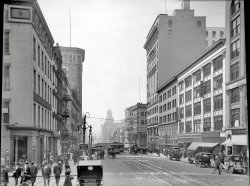
- Daddy's Boy: 1942
- September 1942. "Rochester, New York. Mrs. Babcock, Shirley and Earl greeting Mr. Babcock in ... (The Gallery, Cars, Trucks, Buses, Kids, Ralph Amdursky, Rochester) ... Posted by Dave - 01/28/2017 - 11:54pm -
![Daddy's Boy: 1942 September 1942. "Rochester, New York. Mrs. Babcock, Shirley and Earl greeting Mr. Babcock in front of the house." The nucleus of this nuclear family, orbited by his little electron. Large format negative by Ralph Amdursky. View full size.
A Little Known ModelWhat a strange car in the Babcock's driveway. Look at the Shorpy logo on its right front fender.
[The poor abused apostrophe. Which of these nice people would be "the Babcock"? - Dave]
I think that the word "the" preceding the family's name makes it the collective Babcock family and that that renders my apostrophe unharmed. Not too sure though.
[These people are the Babcocks, and this is the Babcocks' driveway. - Dave]
Too Young & Too OldMr. Babcock falls into that odd category my paternal grandfather also shared. Too young for WWI, yet too old (and supporting a family) for WWII.
Great jobIt really makes you wonder how the photographer was able to shoot the Babcock family in so many situations (listening to the radio, Mom doing the laundry, the boys making a model plane and sleeping at night) and still manage to elicit such genuine emotion as with the dad hoisting Earl in the air upon his return home. It's a credit to his skill at what he does. As for the look on the mom's face, she's obviously a bit more reserved than the others, and it may very well be that she's bursting with pride and happiness at her husband and little boy.
RationingThe "A" sticker entitles him to 3 gallons of gas a week, the lowest civilian grade. You get that if you certify that you own five tires or fewer. The rest had to be turned in.
Daddy's carA 1939 Plymouth.
Defroster/Air ConditionerGotta love the old plug in fan on the dash.
Insufficient DataI've been trying to pin down these Babcocks in the 1940 Federal census.
[Somebody has. - tterrace]
WipersHi, new here as far as a poster but always have looked at the pics daily . Just wondering has anyone here had any experience driving this car in the rain . Doesn't look like the wipers cover enough area to see out of.
[Typical for cars of the period. - tterrace]
(The Gallery, Cars, Trucks, Buses, Kids, Ralph Amdursky, Rochester)](https://www.shorpy.com/files/images/SHORPY_8d27695a1.thumbnail.jpg)
- Welcome Interstate Managers: 1908
- Circa 1908. "Convention Hall, Rochester, N.Y." A Goreyesque tableau awaiting its ill-fated merrymakers. 8x10 ... same view from September of 2019.
(The Gallery, DPC, Rochester) ... Posted by Dave - 08/04/2014 - 8:40am -
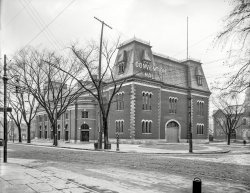
- The Wolverine: 1922
- ... Elmo Lincoln is the only movie star from my hometown of Rochester, Indiana! That's all I've got to say. Some 4-digit population towns ... Posted by Dave - 08/18/2012 - 5:52pm -
![The Wolverine: 1922 Washington, D.C., circa 1922. "Leader Theater, front." Sidney Lust's movie house on Ninth Street N.W. National Photo Company glass negative. View full size.
Into the MixWow. Interesting mix of dancehall cafe, Greek restaurant, vaudeville/burlesque house and cinema. Even in black-and-white, certainly more colorful than the mall multiplex.
Breathtaking ArchitecturePlease tell me this magnificent building is still standing. Built in 1910, it could be . . .please!
The gigantic statuary flanking the marquee---dwarfed by the HUGE roofline finial statues---is simply stunning. All the buildings along this block have unique architecture with intricate detail. Was this an "entertainment block"? I see a cafe/dance hall, burlesque house, the Leader theater, and a Greek restaurant. I wager to say even the "Washington Shoe Shine and Hat Cleaning Parlor" was probably an entertaining place to visit!
The Tarzan die cut advertising tucked around the marquee would be worth a small fortune on today's antique market!
The Port ArthurStarting from the left...
Washington Post, Oct 20, 1914
Fight in Chinese Cafe
Three Men Arrested Following Row in
Port Arthur Restaurant
The moving-picture district on Ninth, between E and F streets northwest, was thrown into a state of excitement last night just as the shows were discharging their crowds by a fight in the Port Arthur Chinese restaurant, in which three young men are alleged to have attempted to smash everything in the shape of furnishings and the head of every Chinese employee in the place.
The trouble attracted a crowd that blockaded the street from curb to curb. Cries and curses and the breaking of glass and tableware added to the situation.
Policeman Miller alone grappled with the fighters and emerged from the place brining three of the principles with him. They were taken to the first precinct.
Morris Sing, proprieteor of the restaurant, told the police that the party came into his place and ordered food. Then for some reason unknown one of the men picked up the dishes, smashed them, and then started a general assault principally against the Chinese employes of the place.
Several of the Chinese waiters were injured, but refused hospital treatment.
A one-sex audienceAll boys, I notice. Apparently girls stayed home on Saturday afternoons. All in knickers, scratchy woolen stockings and high leather shoes. And every single one of them wearing a cap except the half-dozen or so who are holding them in their hands.
Helen Gibson in "The Wolverine." Not much information, I'm afraid.
Elmo Lincoln in "The Adventures of Tarzan." (Lots.)
The WolverineI had no idea Hugh Jackman was so old!
"The Wolverine"Plot Synopsis by Hans J. Wollstein
Based on a novel by the prolific B.M. Bower (pseudonym for novelist Bertha "Muzzy" Sinclair), The Wolverine starred former serial queen and stunt-woman Helen Gibson as a rancher who stands up for an employee (Jack Connolly) unjustly accused of cattle rustling. Ward Warren (Connolly) had come West after serving a prison sentence for a crime he didn't commit. History repeats itself for Ward when a couple of bandits he had chased off the land, accuses him of being a rustler himself. The former common-law wife of Hoot Gibson, Gibson (née Rose Wenger) had gained stardom replacing Helen Holmes in the long-running The Hazards of Helen. By no means a traditional screen beauty -- but spirited -- Gibson's starring career was brief, and she returned to stunt-doubling in talkies.
http://www.allmovie.com/work/wolverine-117381
Around the World in a BlockThe architectural walking tour here is pretty wild. There's the Belle Epoque excesses of the Gayety and Leader theaters, crowned by their zinc copies of sculptures from the Petit Palais at the Exposition Universelle in Paris. Then there's the Gothic church facade of the Port Arthur Restaurant. And then there's the Acropolis (Greek) restaurant housed behind a Chinese balcony, left over from the Port Arthur's old location on the other side of the Gayety (the stairwell entrance to the "gothic" Port Arthur at 515-17 has a matching Chinese carved wood awning). But just when I was getting an urge for some nice spanakopita, I noticed that the Acropolis seems to have been replaced by the all-American Rowland's Buffet.
Cable cars?Is that a cable slot between the streetcar tracks?
[It's access to the underground electrical supply that powered Washington's streetcars. - Dave]
"Fastest Northwestern Picture Ever Screened"What the heck does that mean?
["The Wolverine" was a train. Which is shown in the sign. - Dave]
Coming AttractionView Larger Map
The location today. The J. Edgar Hoover Building is right behind you.
The GayetyThis is right around the corner from the original 9:30 Club. I remember parking across the street from the Gayety in the early 80's. Creepy place, they showed "adult" movies. Lots of drug addicts and perverts.
Wilbur Mills and the GayetyThe Gayety lasted into the 1970s. That's where House Ways and Means Chairman Wilbur Mills first met "Argentine Firecracker" Fanne Fox, who later jumped from his car into the Tidal Basin and sank Mill's career.
Gorgeous photograph!And also a revelation for me. Was The Port Arthur a Chinese food chain? There was also one by that name in downtown Providence. I don't know when it opened there, but I do know that it lasted well into the 1940's and was - according to my Dad - the hottest place to go to on a Saturday night in the late 30's and early 40's. Drinking, dancing to a band and exotic, for its time, Chinese food.
My Aunt Mary and another female relative sang there, as well.
What an eye-opener! And what a thrill this photo is to drink in! I'd throw down my nickel to see that movie in a second - if only for the pleasure of getting to see what the inside of the theater looked like!
This is one of the very best postings this year.
[Below: The Port Arthur Chinese restaurant in New York. Click to enlarge. - Dave]
Helen GibsonThat picture is awesome. Thanks for sharing it. I have been researching Helen Gibson for many years and have many of her personal ephemera pieces. Including her copy of the Wolverine lobby card with the image enlarged as a poster on the left of the entrance. Thanks for your site, I always see something exciting.
Newsboy MatineeGiven all the young boys and the fact that that whatever is going on here it merited a photograph, I am guessing this is another gathering of newsboys for a Saturday matinee. Shorpy viewers have previously seen a similar event in this 1925 photo of the Leader Theater. Alas, no sign of Bo-Bo, "the monkey with the human brain," in the photo.
Washington Post, Feb 12, 1922
Carriers' Theater Party
Many Post newsboys yesterday had the time of their lives at the showings of the latest installment of the Adventures of Tarzan at Sidney B. Lust's Leader and Truxton theaters as the guests of Mr. Lust and the circulation department of the Post. The boys found the day an even greater event than they had expected, for in the morning at their homes, each had received letters from W.C. Shelton, circulation manager of The Post, thanking them for their efforts delivering The Post on time during the storm and enclosing $1 as a bonus.
Mr. Lust, who was host to a number of the carriers yesterday, will entertain as many more today, for tickets good for either day were sent out. As a special inducement to efficient service, the boys who rank among the best carriers in the city will receive free movie tickets for the next 15 weeks.
The boys had been particularly interested in the Tarzan film, which features Elmo Lincoln. Bo-Bo, the monkey with the human brain, was on hand to meet the boys when they reached the Theater, and on leaving every boy was given a bag of peanuts. Bo-Bo plays an important part in the Tarzan serial, and his antics created much amusement.
Elmo!Where else but in America could a guy named Elmo with a 52-inch chest become a movie star? In addition to his rightful claim to fame as the first film Tarzan (in 1918), Elmo Lincoln was also in the silent classics "Birth of a Nation," "Intolerance" and "That Fatal Glass of Beer." He came back in the late 1930s in bit roles in talkies, including "The Hunchback of Notre Dame."
"The Adventures of Tarzan" was Lincoln's third and final foray in the role of the vine-swinger, which was probably just as well, as he was afraid of heights. Released as a 15-part serial, it was one of the smash hits of the year, taking in more than Valentino's "The Sheik."
Sugar Plums at the GayetyWhen this photo was taken, burlesque had not yet begun its long slide from musical comedies and revues into adults-only sleaze. The Washington Gayety was one in a large chain of theaters, with shows rotating among them on a circuit, as in vaudeville. Gayety shows featured such stars as Al Jolson, Fanny Brice, Sophie Tucker and Will Rogers. Harry Coleman, starring in the Washington Gayety's "Sugar Plums," was a comedian who began receiving favorable reviews around 1915, and appeared in a few silent films as early as 1910 (his last film credit is as a bit player in the dance hall scenes in Chaplin's "The Gold Rush"). On Nov. 8, 1918, the Toronto World ran a notice for the Toronto Gayety's new show "The Roseland Girls," beginning with this lead:
"The Roseland Girls" is a show that may always be relied upon to furnish the sort of entertainment that the patrons of the Gayety Theatre will like and will be enjoyed by all classes of theatregoers. The company is headed by Harry Coleman, Bert Lahr, Kitty Mitchell" [and others].
Absolutely wonderful. What a civilization we once had!
The adult on the far right appears to be halting traffic with his blurry arms so as to give the photog a clear view of the newsboys.
Elmo of the ApesElmo Lincoln was in the first Tarzan feature, "Tarzan of the Apes," which was filmed in Morgan City, La. (I suppose if you took the Southern Pacific east out of LA that would be the first quasi-jungle swamp you would come to.)
Morgan City is a real pit, an oilfield blue collar town with not much going for it. In 1986 I was staying overnight there and read in some chamber of commerce brochure an invitation to come back in 1988, for the 70th anniversary of the release of the film and Morgan City's Tarzan fest.
Two years later the Wall St. Journal had an article in its humorous-story corner about how in the midst of all the planning the Edgar Rice Burroughs estate prevented Morgan City from going forward with the festival. The poor town was stuck with all of the preliminary costs of their big event in the city's history. What a shame.
Good thing there was a captionI couldn't see the name of the theatre anywhere on it. I suppose it could be covered by a banner for the movie. You'd never see a business today allowing its identity to be obscured.
Elmo Is My HomeboyElmo Lincoln is the only movie star from my hometown of Rochester, Indiana! That's all I've got to say. Some 4-digit population towns can't claim ANY movie stars.
What is next door?Does anyone read Greek? I wonder what the upstairs of the building on the theater's left houses?
[The name is there in both Greek and English: Acropolis Cafe. - Dave]
Dressed to the NinesI can't imagine a group of that many boys wearing ties to a movie today.
(The Gallery, D.C., Movies, Natl Photo)](https://www.shorpy.com/files/images/30200u.thumbnail.jpg)
- Crackerbox: 1940
- ... you had to go across the Beaver River on the bridge to Rochester to buy a beer or see a movie.
Pillow Talk I remember those ... Posted by Dave - 05/11/2009 - 11:00pm -
![Crackerbox: 1940 January 1940. "Family living in a 'crackerbox' slum tenement in Beaver Falls, Pennsylvania." Medium-format nitrate negative by Jack Delano. View full size.
Geeze...I'm now thoroughly depressed. Can we please get back to those nice scantily clad swimsuit models now?
Why be depressed?Hey - at least this was the exception, in the US.
"By 1965, 38% of houses in Glasgow had no fixed toilet or shower.
"By 1985, 5% of households still did not have a bath or shower." - Glasgow People's Palace (museum)
TightAnd I thought those camping trailers were small.
ReflectionsThe people reflected in the mirror don't seem like they are very close to being down and out, although looks can be deceiving. At least they seem to have retained their dignity.
And what the heck is a "crackerbox slum tenement" anyway?
I lived not far from Beaver Falls, at the little river town of Beaver on the north bank of the Ohio, back in the summer of 1956. It was one of the nicest little towns I've ever lived in, although you had to go across the Beaver River on the bridge to Rochester to buy a beer or see a movie.
Pillow TalkI remember those embroidered pillowcases. I bet Dad usually woke up with the word "Dad" imprinted on his forehead.
A poignant pictureDespite the family's desperate situation there are clues of a happy life framed in this shot. They are safe and warm from the snow storm seen through the window. Their child's dolls are nearby. On the dresser is a treasured portrait of a smiling young couple who are obviously in love. Despite the conditions they find themselves, the mirror reveals them smiling as they look over toward their child in the crib. This is a loving family that will survive their circumstances.
[Revised clue: The kid's on the bed, not in the crib. - Dave]
Door to where?I'm curious about the door behind the bed. It's latched and nailed shut.
The BabyI didn't realize that was a baby until I looked at the photo full sized. The guardian angel on the crib made me choke up.
The DoorThis might have been a room for rent.
Luz artificial.Por la traza de las sombras se aprecia que la luz procede de un punto interior de la habitación. Probablemente de un foco eléctrico o un flash, quizás de magnesio. La luz natural disponible en el interior, seguramente, habría reflejado una imagen más sombría y aún más deprimente.
The DresserThe finial over the mirror is missing. I bought a similar dresser at a yard sale years ago. The top part kept falling off.
The lamp on the dresserThese people owned a very nice "collectible of the future" -- an early 20th century Heintz Art Metal lamp, made by Otto Heintz of Buffalo, of dark bronze with sterling onlays. These are very sought after by collectors of Craftsman style furnishings, and nowadays usually sell for several hundred dollars, unless some eager beaver has polished the bronze. Below is a similar lamp.
Famous BeaveriteJoe Willie Namath was born there in 1943!
Jim and Della - revisitedSomething of this photo reminds me of O. Henry's "The Gift of the Magi". Here we have Jim and Della, some years later, though bereft of their treasures, still the hopeful parents of innocent babes, and still rich in the love they share for each other...
"And here I have lamely related to you the uneventful chronicle of two foolish children in a flat who most unwisely sacrificed for each other the greatest treasures of their house. But in a last word to the wise of these days let it be said that of all who give gifts these two were the wisest. Of all who give and receive gifts, such as they are wisest. Everywhere they are wisest. They are the magi."
Ansel Adams had the Zone System... I'm working on the points system. First I points it here, and then I points it there...
Wake up!That is one limp-looking baby. At first I thought it was a big doll.
NeighborsThe door likely led to another apartment. A lot of houses were subdivided later into apartments and rather than removing the old doorway, the landlord simply nailed it shut. I used to live in single family home converted into a duplex and a good many once-useful doors to the other half of the house were latched/nailed/boarded shut.
My Aching BackYou know that sleeping on that mattress had to be utter torture.
Home Sweet HomeHome is where the Heart is.
Buckle alignmentIt appears that the man, reflected in the mirror, has his belt buckle aligned on his side rather than in front above the zipper. What gives.
[It means he was a former hipster. - Dave]
Belt BuckleMy Gramps wore his that way until he died a few years back. My grandmother says it was cool in the 30's. He couldn't let that fad go; maybe he was waiting for it to come back in style.
Belt buckle bass playersI am a professional classical musician and have noticed that string bass players shift their belt buckles to the side, in order to avoid scratching the finish on the wood in proximity to their bodies.
They may or may not be doing that to be "hip". But it works.
MomI guess she's the one taking the shot. I love her little handbag behind the dresser lamp. And the "Dad" pillowcase.
Pennies from heavenThis photo is so sweet. I love the little details like the scissors hanging from the dresser, the photo of the happy couple and the purse on the dresser. The detail on the lamp is pretty wonderful too. The baby seems pretty blissful to me. Oh and the "Dad" embroidered on the pillowcase.
(The Gallery, Jack Delano)](https://www.shorpy.com/files/images/8c04426u.thumbnail.jpg)
- Wingman: 1942
- September 1942. Rochester, New York. "Earl and Howard Babcock looking over one of the model ... line of thinking.
(The Gallery, Kids, Ralph Amdursky, Rochester) ... Posted by Dave - 01/28/2017 - 11:53pm -
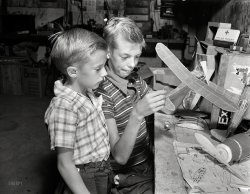
- Epiphany: 1905
- Rochester, New York, circa 1905. "Fountain in reservoir, Highland Park." 8x10 ... Park reservoir was not a success.
(The Gallery, DPC, Rochester) ... Posted by Dave - 08/14/2012 - 10:48am -
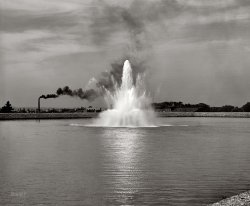
- Despatch Depot: 1906
- ... Co." The New York Central rail hub now known as East Rochester. Panorama made from three 8x10 inch glass negatives. Detroit ... you in my Graphics Dept!!
(Panoramas, DPC, Railroads, Rochester) ... Posted by Dave - 03/06/2018 - 7:16pm -

- Bedtime for Babcock: 1942
- September 1942. "Rochester, New York. The two Babcock boys share one room." Howard and Earl ... and patience!
(The Gallery, Kids, Ralph Amdursky, Rochester) ... Posted by Dave - 01/28/2017 - 11:55pm -
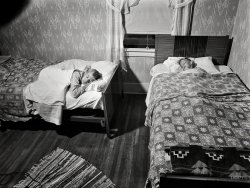
- Hotel Seneca: 1908
- Rochester, New York, circa 1908. "Hotel Seneca." The interior seen earlier ... lower graffiti remediation costs.
(The Gallery, DPC, Rochester) ... Posted by Dave - 01/11/2013 - 9:16am -

- Three Indians: 1915
- ... New York, Poughkeepsie, Albany, Utica, Syracuse, Rochester to:
July 20: 12:45 AM, Buffalo, New York to Erie, Cleveland, ... Posted by Dave - 04/06/2013 - 11:57am -
![Three Indians: 1915 Washington, D.C., July 1915. "Motorcycle team, relay to Frisco." Frank S. Long, F.L. Leishear (whose Indian store we saw here) and Josiah McL. Seabrook. National Photo Company Collection glass negative. View full size.
California, screamin'They sure did take a circuitous route (NYC and then way up to Albany). The stretch from Reno down into Sacramento must have kept the lads awake with fear if that lap's bikes had no front brakes either. The first time I drove from Reno to Sacramento - and this was on a road they could not dream of, I-80 - one item that caught my eye was a sign, "Caution. Downgrades next 40 miles."
Light fantasticThe one smart enough to put the light on his bike will win it for them.
Gold mineThe guys from "Pickers" must be drooling. Maybe they could find out who these men are and see if their families have these bikes behind the barn.
Safety first!At least for the fellow with the tossled hair. He has on his protective gloves!
Rudimentary brakes.Emergency stops much have been pretty exciting on those old bikes- I don't think they even had front brakes. No stoppies for them!
Nice!I've been sitting here soaking up this picture. Just fabulous! Great shot, great clothes, great bikes! Wish I could go for a ride with them.
Thanks again Dave.
Handsome BravesBeautiful bikes! These have many, many similarities to this amazingly restored model, snapped last spring in Charlotte, North Carolina. They may be a bit newer, with kick starter, no leg-power pedals, skirted fender, hand-grip clutch, an electric headlamp on the rear bike (as opposed to Prest-o-Lite [acetylene]), and "soft-tail" rear suspension. I guess any of this could have been optional equipment.
DatingI believe that the date of this photo is probably 1916 and not 1926. The Indians pictured appear to be 1915 models. I believe that 1915 was the last year of the inlet over exhaust engine (which these bikes have)and the first year of the kick starter.
[You are close -- the year is 1915. - Dave]
World's Fastest IndianWhen you see these bikes it really is incredible that Burt Munro took a similar model, a 1920 Scout, modified it and drove it to several land speed records. In 1967, with his engine punched out to 58 cu.in. (950cc) he set a class record of 183.586 mph. To qualify he made a one-way run of 190.07 mph, the fastest ever officially recorded speed on an Indian.
The hogs of their dayLaugh at the funny horn if you like, but those bikes are Indian "standards" with 1,000-cc engines. Too bad they didn't add front brakes until 1928.
Murder Inc.Maybe these fellas were part of the traveling team of hit-men for Murder Inc. They sure look like they want to kill something.
a-OO-gah!Although the braking wouldn't be the greatest, at least they'd be able to clear a path with a mighty squeeze of the horn.
Silent RIt was Shorpy that taught me that these are "Motocycles."
119 Hours to FriscoWashington Post, July 18, 1915.
RELAY RACE TOMORROW
Motorcyclists to Carry Message From Capital to Pacific.
START FROM WHITE HOUSE
Three Washington Men Will Cover the First Lap, From This City to Baltimore -- Expect to Make Cross-Continent Run in 119 Hours -- Secretary of War to Start Riders.
With all arrangements for the transcontinental motorcycle relay race completed, the riders for the first lap of the long journey await the starter's word. The start will be made from the White House at 10 o'clock tomorrow morning. They will carry a message from the President to the officials of the Panama-Pacific exposition at San Francisco.
The Washington team, which will cover the first lap, will be composed of Frank S. Long, F.L. Leishear, and J. McL. Seabrook, mounted on Indian motorcycles. These men will carry the message from here to Baltimore, where another team will take it up and carry it over the second lap which ends in Philadelphia. From there the route across county is via New York, Albany, Buffalo, Cleveland, Chicago, Davenport, Des Moines, Omaha, Cheyenne, Salt Lake City, Reno and Sacramento to San Francisco.
Fast Time Is Scheduled.
On account of the absence of the President, the message will be handed to the riders by Secretary of War Garrison. It is due on the Pacific coast 119 hours after leaving Washington.
The riders in the Eastern part of the country will have little difficulty in keeping up with the schedule on account of the good roads, but some of the Western relays are more than 200 miles in length. The longest lap will be between Elko and Fenley, Nev. This stretch is 274 miles long.
One of the purposes of this relay is to demonstrate the utility of the motorcycle for military use. The relay is intended to show that the motorcycle is capable of delivering messages under all conditions of road and weather. There will not be one minute from the time the message leaves Washington until it is delivered to the officials of the exposition that it is not moving, day and night, rain or shine. The motorcyclists of this country have been as one volunteering their services as dispatch bearers, and it has been a task for John L. Donovan, chairman of the competition committee of the Federation of American Motorcyclists and manager of the relay, to select the riders.
HornyThe furthestmost bike from us has an electric horn, but the others have the bulb variety; I'm guessing it was an optional extra or later add-on. Also interesting to note that heavy cardigans seemed to be the outer garment of choice for moto-cyclists at this time. I wonder when and why the black leather jacket took over.
Front SuspensionIt's called a trailing link suspension as the arm pivots ahead of the axel axle. Not too common at all. I believe some early BMWs used this type for awhile as well.
In All It's Its GloryHere is a picture of a restored bike that is exactly like the ones in the picture. Note the kick start is on the left side and there is no gear shift to the left of the tank. Apparently slightly later models had the space occupied by the kick start mechanism replaced with a transmission that included a gear shift from it to the left side of the gas tank.
Front SuspensionThe Indian front suspension was designed so there was caster to the wheels. According to the old guys I knew 60 years ago, this caster made for very secure handling and less tendency to high speed wobble. You haven't lived until you have experienced a case of high speed wobble!!!
UnpunctualThe messages were delivered 36 hours late according to the article below from The Salt Lake Tribune from July 26, 1915. Research indicates that the riders were trying to show that taking a dispatch on a motorcycle across the country would be faster than placing the same message on a train. As originally scheduled, the race would have gone through Sacramento during the national Federation of American Motorcyclists (FAM) convention in Sacramento, but this did not happen because of the belated arrival of the dispatch rider. The FAM was the organization behind the race. All riders were asked to conduct a rehearsal ride on July 11th.
The purpose of riding in teams of three was to ensure that if something happened to the primary rider or his motorcycle another rider would be immediately available to continue the mission to San Francisco. Of the three riders pictured here, Seabrook punctured a tire before reaching Baltimore, and he dropped out; Long ran into a pile of rocks in Baltimore, and he was injured; so Leishear became the only man to make it to the first transfer point.
By Bryan, Ohio, near the Indiana border, the racers were five and a half hours late because of rains and bad roads. By the time the riders reached Chicago they were 12 hours behind schedule. Some time was made up on the way to Moline, Illinois as the deficit was reduced to just eight and a half hours upon arriving there, and seven hours at Des Moines, Iowa. In Nebraska the lead rider had an accident, but the other riders were far behind him. Consequently, by Rock Springs, Wyoming the riders were 19 hours behind their scheduled arrival, and at Ogden, Utah 18 hours overdue. I did not find where the other 18 hours were lost, but many sources mention the 36 hour late arrival.
The official route, dates, and times as originally scheduled were shown in the Ogden Standard (Ogden, Utah) on July 17, 1915. Note the earlier start time than what actually took place.
July 19: 6:00 AM, Washington. D.C. to Baltimore, Philadelphia, New York, Poughkeepsie, Albany, Utica, Syracuse, Rochester to:
July 20: 12:45 AM, Buffalo, New York to Erie, Cleveland, Toledo, Bryan, South Bend, Chicago, Sterling, Davenport to:
July 21: 3:15 AM, Victor, Iowa to Walnut, Omaha, Columbus, Kearney, North Platte, Julesburg to:
July 22: 3:15 AM, Cheyenne, Wyoming to Pine Ridge Station, Rawlins, Rock Springs, Evanston, Salt Lake City, Ogden to:
July 23: 12:45 AM, Kelton, Utah to Cobre, Elko, Rye Patch Station, Battle Mountain, Tenley, Reno, Colfax, Sacramento, Tracy, to San Francisco.
(The Gallery, D.C., Motorcycles, Natl Photo, Sports)](https://www.shorpy.com/files/images/32280u.thumbnail.jpg)
- Industrial Cataract: 1905
- Circa 1905. "Upper Genesee Falls, Rochester, N.Y." 8x10 inch dry plate glass negative, Detroit Publishing ... May of 1999.
(The Gallery, DPC, Factories, Railroads, Rochester) ... Posted by Dave - 07/28/2017 - 1:29pm -
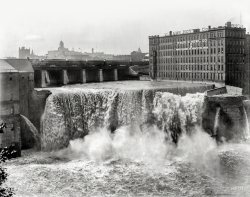
- Nusbaum's Lining Store: 1906
- Rochester, New York, circa 1906. "Masonic Temple, North Clinton Avenue and ... and the like.
(The Gallery, Bicycles, DPC, Rochester, Stores & Markets) ... Posted by Dave - 07/26/2020 - 10:01am -
![Nusbaum's Lining Store: 1906 Rochester, New York, circa 1906. "Masonic Temple, North Clinton Avenue and Mortimer Street." District headquarters of the Free & Accepted Masons, whose retail tenants include Wunder Tailor, Nusbaum's Lining Store, E.J. Egbert & Co. and Underwood Typewriter. This imposing edifice, completed in 1902, was razed in 1932 to make room for a movie theater parking lot. 8x10 inch dry plate glass negative, Detroit Publishing Company. View full size.
Masonic allegoryThe frieze above the column, an allegory for death and mortality, is referred as the "Broken Column".
Know when to stopThe brickwork above the cornice seems superfluous at best; the acroteria adorning it even more. Perhaps it conceals the mechanicals for the new-fangled elevators, but a more graceful enclosure could surely have been designed.
Can someone explain the Lining Store? Does it possibly supply Wunder, next door? The window display has certainly caught the attention of the only non-smudgeperson in the photo.
Buried TreasureThis great little building was razed in 1932 to create a parking lot for the new RKO Palace theater next door. Recently, both lots were converted to a bus terminal and numerous items from the old lodge were found 30 feet below street level. Story below.
https://paigedoerner.wordpress.com/2014/01/09/masonic-sculptures-discove...
Take your pickThe movie theater parking lot is also gone. Today this location is either a bus station or a parking garage. The loss of this building is a shame. Because of masonic philosophy, their temples are exceptionally well built. There is a recent story of a couple who bought a 90yr+ masonic temple in Huntington, Indiana and are converting it into a private home. The article does not mention any structural problems, plumbing issues, or even a roof leak. Granted, it's challenging to find an alternate purpose for a temple.
Lots to joinThe Lodge appears to have a good assembly of dependent orders also. On the façade I see symbols for the Scottish Rite, the Knights Templar, the Eastern Star, and the Nobles of the Mystic Shrine. I’m not sure what the cornice allegory is about, although it might have to do with Hiram the Widow’s Son. The branch could be the branch of acacia which was supposed to mark his grave.
Lining Store?Like Bob down below, I's be interested to know what the Lining Store provided linings for. A quick dive into Google didn't help.
1906 Drone? How would a photographer get this vantage point? It seems too tall for a ladder, and too close to be from a building across the street. I know they didn't have drones in 1906. Did they?
[For an 8x10 view camera. this is not "too close" to be across the street. - Dave]
Whose Lining?A lining store sold wool, silk, and other fabrics used to line women's skirts. They also sold petticoats and other unmentionables.
Also, today I learned that Li-Ning is a line of badminton gear.
Great minds think alikeArchfan, I must have done the same search as you! Badminton, anyone?
Unconscious Lovecraftian touches?The antifixes (I think that's the right term. I mean the small sculptural features along the top of the roof) have a real Cthulhu vibe to my eye.
[Antefixes. See also: acroteria. - Dave]
The whole thing??An entire store devoted to fabric for linings?!? The mind boggles...
While we still have specialized fiber stores today ( trimmings, closures, quilting, etc ), I've never heard of a lining store.
A testament I suppose to our ancestors' predilections for petticoats, chemises, drawers, combinations and the like.
(The Gallery, Bicycles, DPC, Rochester, Stores & Markets)](https://www.shorpy.com/files/images/SHORPY-4a12119a1.thumbnail.jpg)
- A Tehama Home Companion: 1940
- ...
I can still remember Dad laughing at Jack Benny and Rochester.
Mute I have this exact radio but one of the wires came loose ... Posted by Dave - 01/22/2008 - 2:00pm -
![A Tehama Home Companion: 1940 November 1940. Tehama County, California. John Frost and his daughter listening to the radio in their home. View full size. Medium format safety negative by Russell Lee for the Farm Security Administration.
CostI wonder how much this radio cost? It looks like a pretty high end piece of equipment for someone who quite frankly doesn't look like he can really afford it. The again I sometimes wonder how a lot of people who are buying HDTVs can afford it.
tuning dialInteresting to see that the medium-wave am-broadcast band
is "split" (550 kHz-1300 kHz and 1400 kHz- well up to what
back then were common police dispatch/car frequencies).
The top segment may be short-wave (c. 7-MHz to ?) with the
cities/countries listed on it. Of course kHz=kc/s and
MHz=Mc/s in that era as well.
Wedding present or bought on installment by a news junkiePerhaps it was a wedding gift, or it was bought on installment, no credit in those days. It's possible the hubby was a news junkie; remember the year, and the war clouds gathering--shortwave radio would be like the CNN of the 40's. It'd be expensive, but as a commenter said about HDTV it would be the thing to get. Note also the big bound books in the background: dictionaries or encyclopedia volumes?
RadioMy grandparents had one like this, maybe even bigger. I didn't understand all the applications but there was an image of the world and a switch that let you light up different parts of the globe--maybe short wave?
Maybehe wanted a greeeat big set so he could hear it out in the yard.
Radio It might be that the radio and the books are all he has left from better times. I am glad to see that he was getting his child involved in the world. So sad that some respondents try to compare it to today's world and are ready to criticize on such meager information.
Fred AllenI'm reminded of what Fred Allen said: ''I don't hold with furniture that talks.''
Denny Gill
Chugiak, Alaska
RadioMy radio buddy says its an RCA 19K. So yeah, a big console by a name brand. They must have made sacrifices to get that one. I hope they enjoyed it!
The RadioI stand corrected. Thank you, Dave.
Radio techie detailsNow that the unit has been identified, here are some more techie details about it for those interested in such.
http://oldtech.net/RCA/19K-sch.gif
http://oldtech.net/RCA/19K-p1.gif
http://oldtech.net/RCA/19K-p2.gif
http://oldtech.net/RCA/19K-p4.gif
The pushbutton preset tuning is explained. The tuning dial shows that it did cover a goodly chunk of the shortwave bands (1.4-4 and 6-18 MHz). The same tube types were being used in some equipment still produced into the early 1960's.
Re: RadioIn Dave's close-up detail of the dial bezel, the brand name looks like Zenith to me, not RCA.
[It says RCA Victor. - Dave]
John FrostRe Brent's comment, you can read a lot into a photo that may or may not be there. In the 1940's my college educated, former Naval officer grandfather bought a run down farm with no indoor plumbing. In fact, they didn't have indoor plumbing until the 50's. He had some money and more dreams. He valued education and followed world events but he lived much like this guy lived....with mud & manure on his boots and his child on his lap! I can imagine him in this very pose listening intently to the world news. He died a millionaire many years later. A picture may speak a thousand words but it still doesn't tell you the whole story!
[More on John Frost: "Mr. Frost is part owner of 135 acres of semi-marginal land in Tehama County, California. He has a family of seven. His crops are turkeys, hogs and dairy cattle. He is a Farm Security Administration client." He also had a piano. - Dave]
Radio DaysI was born in 1933, and some people we knew would spend a lot for a big radio. You could buy them on an installment plan. Often, this was the nicest thing in their house.
It was the only thing bringing the world to us, since we lived out in the country. We didn't get a newspaper. My dad thought they were wildly extravagant and ours was a tabletop Truetone from Western Auto, also bought on installments. We had a windmill charger for the batteries.
Even though it was little, we could hear it all over the house and outside, too. It was next to a window, with the wires for the antenna and charger going outside. I still have that radio and it still works after I fixed it.
I can still remember Dad laughing at Jack Benny and Rochester.
MuteI have this exact radio but one of the wires came loose from the back of the speaker. I can't begin to see where it was connected in order to reconnect it. Can anyone help or does anyone know of a speaker I can buy? The number on the back of the speaker is RL70J1 and the number on the coil is 89610-504.
Fond memories of the Good Old Days listening to the RADIO My great grandmother owned a radio similar to this one. I remember gathering around the radio listening to "The Squeaking Door" as the light from the kerosene lamp flickered around the room. The year was 1942 and I was seven years old. My great grandmother raised a Victory garden - her part in the War effort. She also raised chickens, cows, and pigs. She wasn't a wealthy woman but we ate well. It occured to me that she may have sold a hog to pay for the radio. The radio sat near a window. I'm wondering if maybe the antenna wires were run outside the window. And the battery - I am also wondering if the battery had to be charged and how that was done. Can anyone help?
Beautiful old radioI have an RCA 111K, which is very, very, similar to the one pictures. It is a great sounding radio.
(The Gallery, Kids, Russell Lee)](https://www.shorpy.com/files/images/8c00054u.thumbnail.jpg)
- No Heavy Teaming: 1908
- 1908. "Arnold Park -- Rochester, N.Y." Our title comes from the traffic sign on the median. 8x10 ... same view from September of 2019.
(The Gallery, DPC, Rochester) ... Posted by Dave - 06/08/2017 - 12:21pm -
![No Heavy Teaming: 1908 1908. "Arnold Park -- Rochester, N.Y." Our title comes from the traffic sign on the median. 8x10 inch glass negative, Detroit Publishing Co. View full size.
Searching The Heavens On A Quiet StreetThe Warner Observatory (dome at right of photograph), financed by Hulbert Harrington Warner, was completed 1882 and the building was demolished 1931.
The History And Work Of The Warner Observatory:
“The Warner Observatory is distinctively a private institution built for the purpose of original discovery rather than the ordinary routine work of most other observatories. The desire of its founder was that the great telescope (then the third largest in the United States) be used in such work; so, selecting as my principal field of labor, the discovery of new nebula, which, since the death of the Herschels and of D’Arrest, had been much neglected, and to which work the quest for faint comets had well trained my eye (an important factor), and also because of its congeniality to my taste (another influential consideration), on July 9, 1883, a thorough and systematic search was inaugurated for this class of objects, which were popularly supposed to have been exhausted, a verdict which the fair measure of success, up to this writing, quite disproves. In this work occasional assistance has been received from my son Edward, now a lad of fifteen years, who has discovered twenty-one.”
Full text, with description and interior photographs.
Hold Your HorsesNO HEAVY TEAMING OR FAST DRIVING ALLOWED.
Heavy Teaming is my new rock-band name.It used to be Peristalsis.
Arnold Park TodayFrom East Ave on 6/8/2017.
No Heavy TeamingI wonder why "No Heavy Teaming"? Was it to reduce vibrations in the observatory telescope or were they afraid of damage to the road surface?
[Today's equivalent would be "No Trucks Over X Tons" signs on residential streets. -tterrace]
+111Below is the same view from September of 2019.
(The Gallery, DPC, Rochester)](https://www.shorpy.com/files/images/SHORPY-4a23077a.thumbnail.jpg)
- Patriotic Gesture: 1942
- September 1942. Rochester, New York. "Earl Babcock's school day begins with the salute to the ... pass.
(The Gallery, Kids, Patriotic, Ralph Amdursky, Rochester) ... Posted by Dave - 01/28/2017 - 11:51pm -
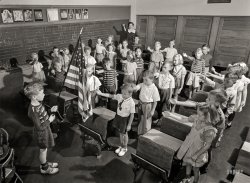
- Despatch Depot (Detail)
- ... of the New York Central rail hub now known as East Rochester. 8x10 inch glass negative. View full size.
Time Traveler ... Minnie over in Elmira.
(The Gallery, DPC, Railroads, Rochester) ... Posted by Dave - 03/07/2018 - 3:18pm -
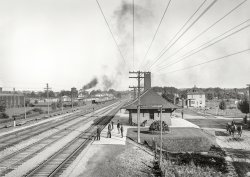
- Hamburgs 10 Cents: 1940
- ...
Regionalisms I recall that in the area around Rochester, New York, in the mid-'50s, what most of the world calls the ...
I can also recall from several road trips from Rochester to Ohio that in the little stretch of littoral Pennsylvania in ... Posted by Dave - 03/27/2019 - 7:29am -
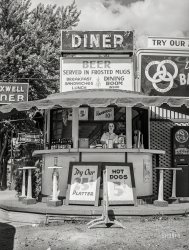
- The Kodak Girl: 1909
- ... Premo Camera, made by "Eastman Kodak Co. successor to Rochester Optical Co.", with the original box and operating instructions. The ... Posted by Dave - 03/21/2011 - 7:53pm -
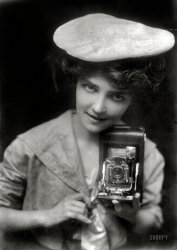
- Luxe Lodge: 1908
- ... 1908. "Elks Temple (Eureka Club), Clinton Avenue North, Rochester, N.Y." 8x10 inch dry plate glass negative, Detroit Publishing ... roman work and perfectly apropos.
(The Gallery, DPC, Rochester) ... Posted by Dave - 06/14/2015 - 12:10pm -
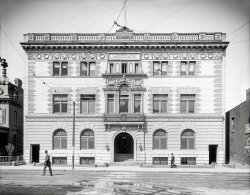
- Student Nurses: 1942
- Sept. 1942. Rochester, N.Y. "Shirley Babcock at right in the front listening to a lecture ... work as well!
(The Gallery, Medicine, Ralph Amdursky, Rochester) ... Posted by Dave - 06/28/2013 - 9:08am -
